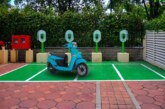
Interview with EV Startup Orxa Energies Co-Founder Ranjita Ravi
Orxa Energies is a Bengaluru based electric vehicles startup is all set to launch its all-electric two-wheeled motorcycle ‘Mantis’ by early-mid 2020.
Electricvehicles.in team has interviewed one of the Co-founders of Orxa Energies, Ms.Ranjita Ravi.

Interview with EV startup Orxa Energies Co-Founder
Tell us about Orxa energies, and what made you design the Mantis?
When we started off, we just wanted a performance electric motorcycle. We looked around and found no such motorcycle in the market – internationally, few players existed like Zero Motorcycles. As we spoke to riders, we realized that both performance & range were critical. You can say that we started Orxa Energies because we were searching for an electric motorcycle that We wanted to ride but found none. And what better way to do so than build one ourselves!
As we started building & testing our prototypes, we realized that the “energy solution” piece of the puzzle remains unanswered. Hence, we decided to take our battery packs to market. These packs have a greater power output, at lower weights, with advanced, proprietary thermal management – multiple patents have already been filed around our tech. Our Automotive packs are “Off the Shelf”, swap-ready, & modular. These battery packs are now clocking fast-growing sales, with customer pilots in execution.
In a way, you can say that we’re solving each problem of the EV value chain sequentially; and offering each solution as an offering to our clients. Our vision is to rapidly electrify all transport. Plain & simple as that.
Is your startup a Make in India or Made in India?
We are and will continue to be completely “Made In India”. The entire vehicle, from the wheels to the handlebars, are designed & assembled by us. We work with manufacturers for critical sub-assemblies. We already manufacture & sell our battery packs, that are completely designed & assembled in our facility in Bangalore. We currently only import cells for the packs.
The challenges, of course, remain very similar to other EV start-ups – vendor ecosystem being the biggest issue. A lot of automotive component manufacturers are not geared to work on the small scale required by early-stage start-ups – some of them are also not willing to work with start-ups. And early-stage start-ups are often not funded well enough to put down tens of lakhs or even crores required for the tooling & machining. It takes a long time for us to find & build a supportive vendor network.
There are some good things happening in the space through- the recent reduction in the import duties, the different state-level initiatives for encouraging EVs, and the expected FAME II for Mar 2019
For manufacturing, we’re working with some of the best automotive component suppliers in India. As you will know, India is one of the top markets in the world for Automotive components & sub-assemblies. This is something we keep in mind as we build, establish, and grow our engagement with suppliers, vendors and partners of all sizes. We’re truly grateful for the large established auto component makers & suppliers who’ve come forward to support us & work with our unique designs to bring the Mantis closer to reality.
To quote Jeff Bezos, we are moving “step-by-step, ferociously” (‘Gradatim Ferociter’). You can look forward to our battery pack assembly growing and a rapid increase in battery sales. On the vehicle side, we will be completing the automotive certification for Mantis and looking forward to its market launch.
You are making Mantis and Mantis Trike, what’s the difference between them, is it only the extra wheel? As of our knowledge, we know Mantis bike range is 200 km and 140 km/hr top speed. Can you share other specifications of this bike and its expected price? Is Mantis bike looks like the same in this video https://www.youtube.com/watch?v=b6Xo12uMBu0 , or you modified the design
Our first vehicle is Mantis. Just like its namesake, the Mantis is a stealthy ambush predator. Designed as an early-performance Street bike, it has a top speed of 140+ kmph and a range of ~200kms per charge.
For our users, the Mantis motorcycle will be among the earliest entrants into the performance electric category. Design, Ride-pleasure and Performance is what we are working to deliver. We want to provide a credible electric alternative to petrol motorcycles for serious bikers.
The speeds and range will allow our riders to be comfortable on all types of city roads and on highways, while the battery-swap option opens up the scope of electric biking to a whole new level.
The Mantis will be available as both a bike & a reverse-trike. A reverse-trike format is unique and is more stable than a normal bike. Our proprietary tech around the mechanism allows for the same footprint as a normal bike. The Mantis Bike will be launched first.
That particular video shows an early prototype. The design has been refined & updated. We will be announcing a public Launch date very shortly. And also events where people and interact with the Mantis motorcycles.
Your team said the battery is 9kgs weight, is it lithium-ion or any other chemistry?
Our Automotive packs are “Off the Shelf”, swap-ready, & modular. They are stackable. They are currently in pilots in different vehicle formats. They use lithium-ion chemistry, as this is most optimized for both cost & energy density at the moment. Having said that, all of our battery technology is “Chemistry-Agnostic” and we believe in using most energy-dense, commercially-viable chemistry at the time.
There are clearly different camps in Battery & Energy technology today: Batteries, Super-capacitors, Lithium, Non-lithium, Hydrogen, Sodium, Silicon, etc. One clear fact is that Lithium is not vanishing in the near future. Further, the Indian eco-system has a long way to go in good quality Li-cell R&D and Li-cell manufacturing before we can be globally competitive (let alone claim “expertise”).
As a start-up that has been boot-strapped for about 85% of our existence, we have chosen to be application-oriented, and hence our focus areas & IP are around battery packs, design, assembly, thermal management, performance management, and their integration.
At Orxa, we are strong advocates of Battery Swap, to tackle biases of up-front cost, range anxiety and charge time & charging space (parking space). We believe that battery swap is a win-win for rapid electrification of 2W and 3W transport- especially shared mobility in India, where minimal vehicle downtime is a critical factor.
We heard you are launching this bike in 2020. Is the date is fixed or we need to wait for one more year?
We expect to launch the Mantis motorcycles by early-mid 2020. We will be announcing a public Launch date very shortly. And we will also be soon announcing events where people and interact with the Mantis motorcycles.
What’s your opinion on the current EV market in India? , Do you think FAME II scheme, tax benefits for EVs can bring the growth in EVs? , Do you think the 5% GST on EVs is Right decision or No GST on EVs is the right option?
We believe that the EV space in India is still very nascent. Multiple things could work out. Shared Mobility, Last mile connectivity – both in 2-wheeler and 3-wheeler space is a ripe & low-hanging target to electrify very quickly. Personal 2-wheelers will electrify next. As an industry, India should target these two objectives, as India is a predominantly 2wheeler market (80% of India’s vehicles are 2W, and there are 20M 2Wheelers sold each year).
In the longer term, personal vehicles like electric cars could see acceptance. Heavier vehicles like buses & trucks will require stronger policy/govt support or development of infrastructure before they become acceptable/ prevalent. GST and other such incentives are nice for demand generation, but it is important to have good vehicles on the road first. If the product is not good, if it does not meet the consumers’ demands, if there is no “product-market” fit, then incentives are only temporarily helpful.
The EV industry in India has had many false starts over the last decade. Earlier we had the Reva car, but no other players. Today, there is a concerted effort between the Central & State Governments in India along with many industry leaders on pushing the Green Mobility agenda in India.
The EV industry has witnessed a growth of 124 per cent selling 56,000 units in the fiscal year 2017-18 as against 25,000 units in the previous year. Electric two-wheelers showed substantial growth of 138 per cent with 54,800 units sold in FY2017-18 compared to 23,000 in the previous year.
The key reason behind the success of electric two-wheelers is affordability and they’re used for short commutes which eliminate range anxiety.
In 2017-18, top six Indian manufacturers sold >20 Million two-wheelers! Only about 18 to 20K two-wheelers sold were electric. In the same year, China’s annual production of just electric two-wheelers is 20 Million! Early negative perceptions on EVs, their poor performance & range anxiety contribute to the poor adoption in India.
We hope to change people’s perception of this poor performance by bringing high-performance fully electric motorcycles on the road soon.
Our sincere thanks to the co-founder of Orxa Energies for sharing her views through the interview.
For any promotions and advertisements on electricvehicles.in, please send an email to support@electricvehicles.inFor the latest electric vehicles news, followelectricvehicles.in on Twitter, Instagram, Facebook and subscribe to our YouTube Channels-English, Hindi & Telugu







